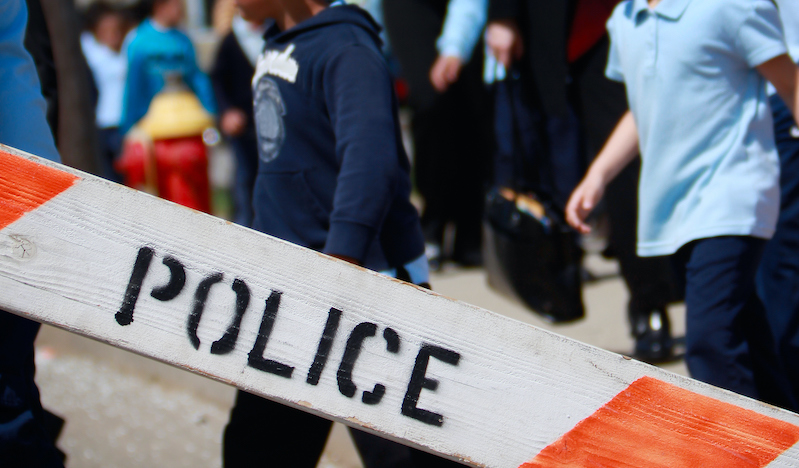
A legal scholar advocates the removal—rather than the increased regulation—of police forces from schools.
Federal and state governments in the United States have invested nearly $2 billion in school policing programs over the past two decades. By using these funds to hire school resource officers—sworn law enforcement personnel who work in schools—school officials aim to ensure student safety by quelling the specter of gun violence that looms over American campuses.
But Barbara Fedders of the University of North Carolina School of Law argues in an article that, much to the contrary, police presence interferes with school governance, negatively impacts student learning, and leads to the overrepresentation of youth of color in the criminal legal system.
Funding for police presence in schools has increased dramatically over the years. In the aftermath of the Columbine massacre at a Colorado high school in 1999, the federal government’s COPS in Schools program disbursed $68 million for the deployment of police in public schools nationwide. Five years later, COPS in Schools had awarded another 3,000 grants funding thousands of additional school resource officer positions. And following school shootings in 2018 in Florida and Texas, states allocated an additional $965 million toward increasing law enforcement presence in schools.
Although intended to promote safety, locating police officers in schools can also cause problems. Juvenile law experts and students’ rights advocates alike have proposed a number of regulatory fixes to address such issues. In her recent article, though, Fedders suggests that more regulation is not the answer. She argues that the removal of police from schools—rather than the regulation of their practices—is the best way to eradicate the effects of what has become a school-to-prison pipeline.
According to Fedders, one method of regulation touted by some scholars would focus on altering criminal procedure doctrine so that it takes into account the unique characteristics of school settings and the young people that inhabit them. Some reformers propose changing Fourth Amendment doctrine to treat school police as traditional law enforcement officers rather than school officials. Fedders suggests, however, that police presence in schools will likely continue driving students into the criminal legal system despite such reforms, since officers would still be free to make arrests for minor infractions.
Other scholars advocate ex ante regulatory measures rather than changes to the procedures for arrests and criminal adjudication. These proposals would increase the regulation of eligibility criteria or would impose training mandates for school resource officers. Nonetheless, Fedders deems such regulatory strategies as inadequate to ameliorate the harms of in-school policing. She points to one study on police academy training programs that found that only 1 percent of officers’ training time, on average, was spent on juvenile justice issues and school policing techniques.
With no federally approved training standards, Fedders finds vast inconsistencies in federal and state training programs and guidance. Federal guidance issued by the U.S. Department of Education and the Department of Justice in 2014 recommended enhanced training for school resource officers, but the Trump Administration rescinded that guidance in 2018. It has not been reinstated.
Fedders notes that states rarely step in to fill the regulatory voids left by gaps in federal guidance on training. Furthermore, she suggests that it is unlikely that the school resource officer industry will impose training-related regulations upon itself. Although the National Association of School Resource Officers recommends minimum training standards for school resource officers, the local law enforcement agencies that dispatch officers to schools are free to disregard such recommendations.
Another approach to regulating school resource officers would be to see schools enter into voluntary cooperative agreements with law enforcement agencies to set clear expectations on when and how officers are to become involved in issues of student misconduct. To support such efforts, the Education Department and the Justice Department established the “SECURe Local Implementation Rubric,” a tool designed to guide school districts seeking to implement these kinds of school-police partnerships.
Fedders concedes that cooperative agreements between schools and law enforcement agencies likely would be responsive to concerns about the school-to-prison pipeline, as they might slow the influx of school-based offense cases into juvenile court and help to prevent officers from committing violations of students’ rights. She asserts, though, that these agreements are not strong enough to regulate the behavior of school police officers because they often contain loopholes for police discretion. Moreover, Fedders notes that such agreements are usually drafted by political actors whose motives are misaligned with the interests of students and their families.
Fedders argues that policymakers need to consider “an option that is hiding in plain sight: remove police from schools.” She proposes that policymakers should begin looking to the work of grassroots anti-school-police organizers to glean inspiration. She sees the call to remove police entirely from schools as an abolitionist effort that holds the power to unite advocates of students’ rights.
Rather than asking how to regulate police in schools, Fedders concludes that the right question for policymakers to ask is whether police should be in schools in the first place.



